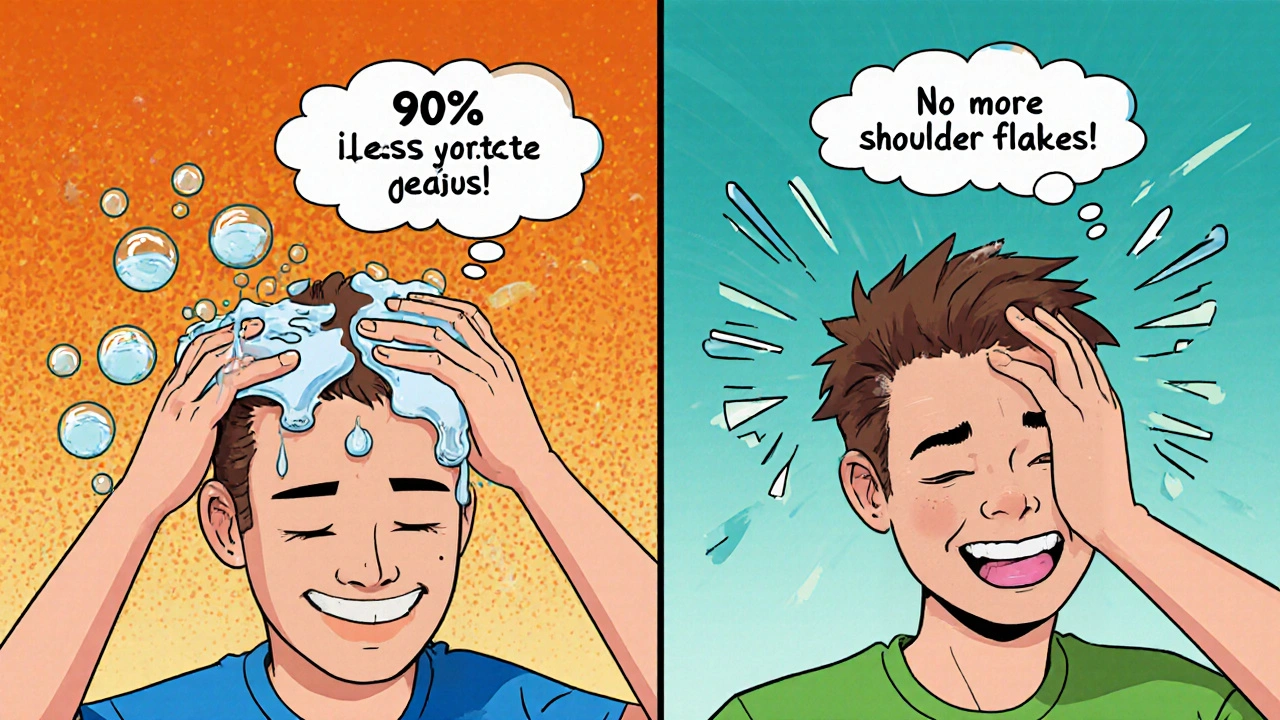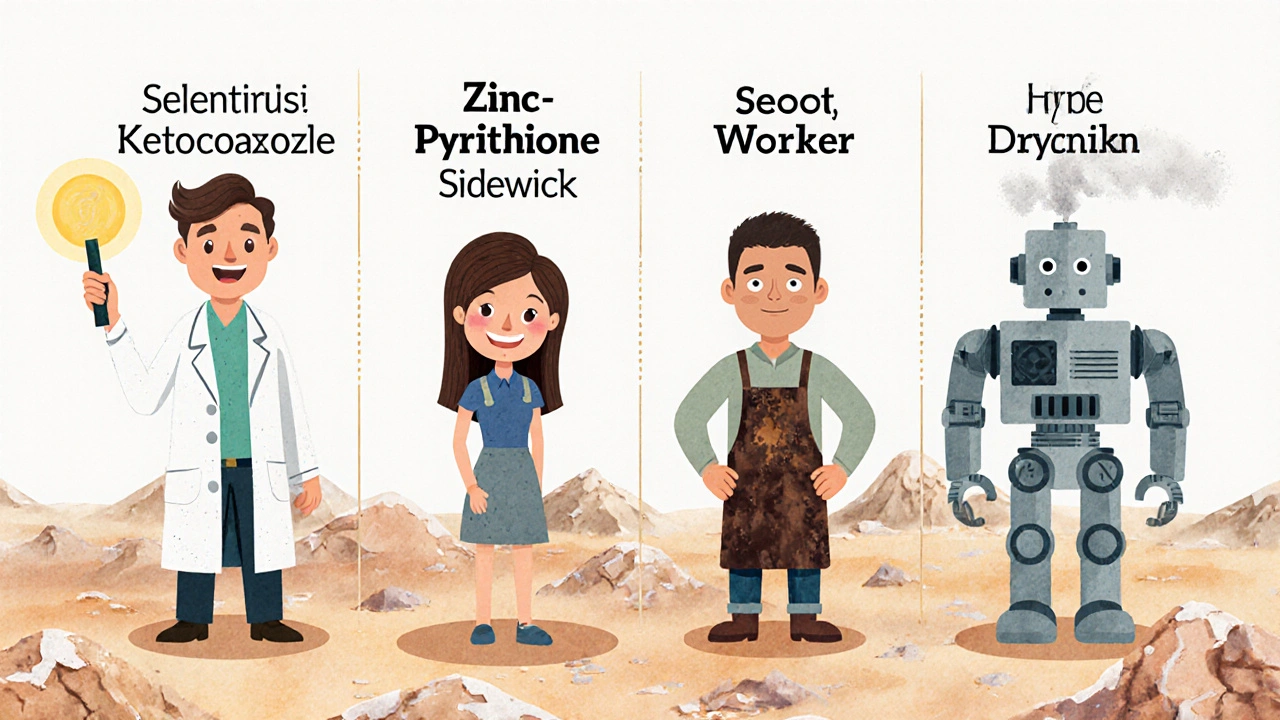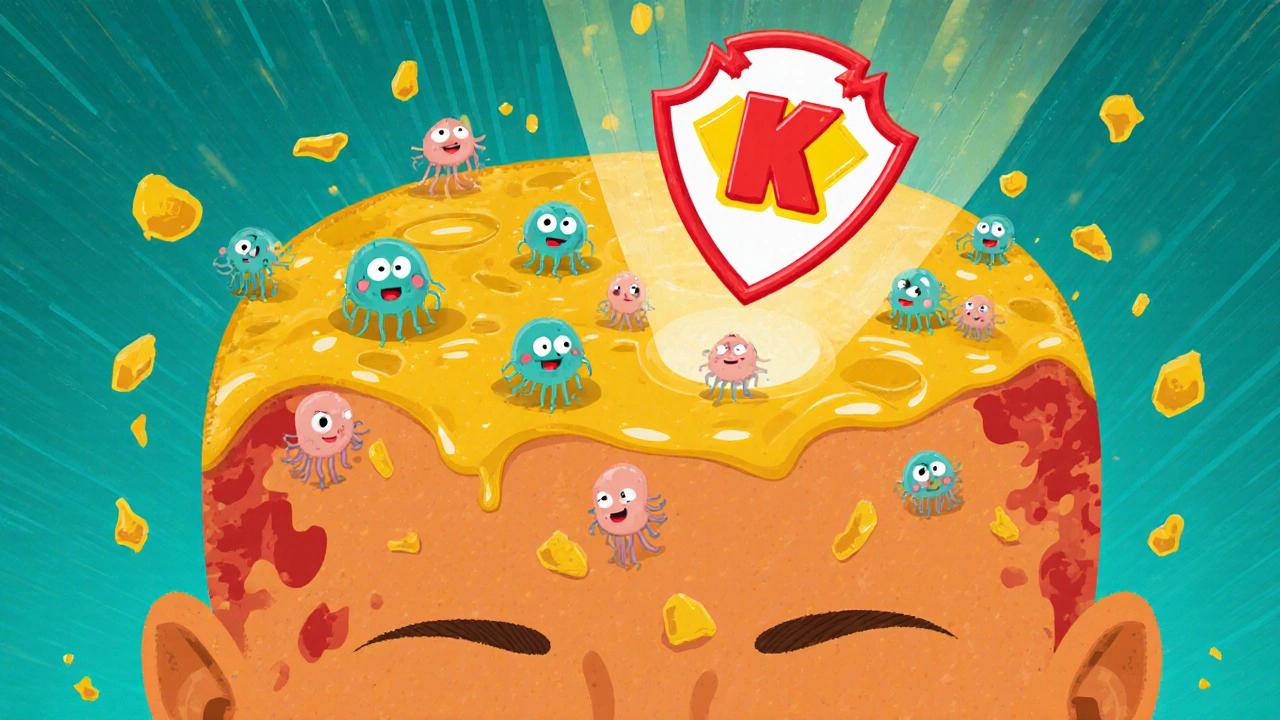Ketoconazole shampoo isn’t just another drugstore product-it’s one of the most effective over-the-counter treatments for stubborn dandruff and seborrheic dermatitis. If you’ve tried zinc pyrithione, coal tar, or salicylic acid shampoos without lasting relief, ketoconazole might be the missing piece. Unlike regular dandruff shampoos that just flake away surface debris, ketoconazole targets the root cause: an overgrowth of Malassezia yeast on your scalp. This yeast isn’t harmful for most people, but when it multiplies too fast, it triggers inflammation, redness, itching, and oily flakes that stick to your hair and shoulders.
What Ketoconazole Shampoo Actually Does
Ketoconazole is an antifungal agent that slows down the growth of Malassezia yeast. Studies show it reduces yeast counts by up to 90% after just two weeks of regular use. It also has mild anti-inflammatory properties, which helps calm the red, irritated patches common in seborrheic dermatitis. This condition isn’t just dry skin-it’s often confused with psoriasis or eczema, but it’s distinct. It shows up as greasy, yellowish scales on the scalp, eyebrows, nose folds, or behind the ears. Ketoconazole shampoo works on all of them.
It’s available in 1% strength over the counter (like Nizoral A-D) and 2% by prescription. The 2% version is stronger and faster-acting, but the 1% version works well for maintenance. You don’t need a prescription unless your doctor says so-most people start with the OTC version.
How to Use It Correctly
Using ketoconazole shampoo wrong is why so many people think it doesn’t work. Here’s the exact routine:
- Wet your scalp thoroughly with warm water.
- Apply a quarter-sized amount of shampoo directly to your scalp-not your hair length.
- Gently massage it in with your fingertips for 3 to 5 minutes. Don’t scrub hard; you’re not trying to exfoliate, you’re trying to let the medicine sit.
- Leave it on for 3 to 5 minutes. This is critical. If you rinse it off after 30 seconds, you’re wasting it.
- Rinse completely with cool or lukewarm water.
Do this twice a week for the first 2 to 4 weeks. That’s the treatment phase. After that, switch to once a week or every other week to keep symptoms under control. Most people see noticeable improvement in 1 to 2 weeks. Full results usually take 4 weeks.
What to Expect in the First Few Weeks
Don’t panic if your scalp feels worse before it gets better. In the first week, you might notice increased flaking or mild burning. That’s your scalp reacting to the yeast die-off. It’s temporary. If itching gets unbearable or you develop swelling, stop using it and talk to a dermatologist.
Some people report their hair feels drier than usual. That’s normal. Ketoconazole removes excess oil, which is good-but it can strip natural moisture. Follow up with a gentle, fragrance-free conditioner on the ends only. Avoid heavy oils or pomades on your scalp; they feed the yeast and undo your progress.

Who Shouldn’t Use It
Ketoconazole shampoo is safe for most adults, but avoid it if:
- You’re allergic to ketoconazole or any ingredient in the formula (check the label-some contain propylene glycol or parabens).
- You have open sores, cuts, or severe burns on your scalp.
- You’re pregnant or breastfeeding and haven’t consulted your doctor.
- You’re using it on children under 12 without medical advice.
If you have eczema or rosacea, ketoconazole can help-but it might irritate sensitive skin. Patch test it behind your ear first. Wait 24 hours. If no redness or itching shows up, it’s safe to use on your scalp.
How It Compares to Other Treatments
| Treatment | Active Ingredient | How Often to Use | Time to See Results | Best For |
|---|---|---|---|---|
| Ketoconazole Shampoo | Ketoconazole | 2x/week (then 1x/week) | 1-4 weeks | Yeast-driven flaking, oily scales, persistent cases |
| Zinc Pyrithione Shampoo | Zinc pyrithione | Every other day | 2-6 weeks | Mild dandruff, maintenance |
| Ciclopirox Shampoo | Ciclopirox | 2x/week | 2-4 weeks | Resistant cases, sensitive skin |
| Coal Tar Shampoo | Coal tar | 2-3x/week | 4-8 weeks | Thick, crusted plaques |
| Selenium Sulfide | Selenium sulfide | 2x/week | 1-3 weeks | Severe flaking, oily scalp |
Ketoconazole stands out because it targets the biological cause-not just the symptoms. Zinc pyrithione is good for mild cases, but if your flakes come back every few weeks, ketoconazole is more likely to break the cycle. Ciclopirox is similar in strength but harder to find and more expensive. Coal tar works but smells awful and stains clothes. Selenium sulfide can dry out your scalp too much.
Long-Term Use and Maintenance
You don’t need to use ketoconazole shampoo forever. Once your scalp clears up, switch to a maintenance schedule: once every 1-2 weeks. Some people use it monthly and stay clear for months. Others need it every week if they have chronic seborrheic dermatitis.
Don’t stop using it just because your scalp looks fine. The yeast is still there, hiding in the folds of your skin. Stopping too soon is the #1 reason symptoms return. Think of it like brushing your teeth-you don’t stop after one cavity is filled.
Pair it with a gentle, sulfate-free shampoo on non-ketoconazole days. Avoid styling products with alcohol, silicone, or heavy oils. Wash your pillowcases twice a week. Sweat and heat trigger flare-ups, so shower after intense workouts and let your scalp breathe.

When to See a Doctor
See a dermatologist if:
- Your scalp becomes painful, swollen, or starts oozing.
- You develop red, scaly patches on your face, chest, or back.
- You’ve used ketoconazole shampoo for 8 weeks with no improvement.
- Your hair starts thinning or falling out in patches.
These could signal psoriasis, fungal infection, or another condition that needs different treatment. A doctor can do a skin scraping to confirm the cause. Don’t assume it’s just dandruff if nothing’s working.
Real Results, Real Stories
One user, 34, had oily flakes for 10 years. Tried 7 different shampoos. Switched to 2% ketoconazole twice a week for a month, then once a week after that. Said: "Within two weeks, my shoulders stopped looking like I’d been snowboarding in January. After three months, I forgot I even had dandruff. I still use it every 10 days-and I haven’t had a flare-up in over a year."
Another, 47, had red, itchy patches behind her ears and on her nose. Used 1% ketoconazole shampoo twice a week for six weeks. The patches faded. She now uses it every two weeks as prevention. "I thought I’d need steroids forever," she said. "Turns out, it was just yeast the whole time."
These aren’t outliers. Clinical trials show 70-80% of people with moderate to severe seborrheic dermatitis see significant improvement with ketoconazole shampoo.
Can I use ketoconazole shampoo every day?
No. Daily use can dry out your scalp and cause irritation. Stick to 2x per week during treatment, then reduce to 1x per week or less for maintenance. Overuse doesn’t make it work faster-it just increases side effects.
Does ketoconazole shampoo cause hair loss?
No. Ketoconazole shampoo doesn’t cause hair loss. In fact, by reducing scalp inflammation, it may help improve hair growth in people whose thinning is linked to seborrheic dermatitis. If you notice hair falling out, it’s likely due to another cause-stress, hormones, or an underlying condition.
Can I use ketoconazole shampoo with other medicated shampoos?
Yes, but not at the same time. Alternate them-use ketoconazole on Monday and Thursday, and zinc pyrithione on Wednesday and Saturday. Don’t mix them in one wash. Using multiple antifungals together can irritate your scalp and doesn’t improve results.
Is ketoconazole shampoo safe for colored or treated hair?
Yes. Ketoconazole shampoo doesn’t strip color or damage chemical treatments like keratin or relaxers. However, because it removes oil, your hair might feel drier. Use a moisturizing conditioner on the ends and avoid hot water when rinsing.
How long does a bottle of ketoconazole shampoo last?
A 6-ounce bottle lasts about 2-3 months if you use it twice a week. If you switch to maintenance mode (once a week), it can last 4-6 months. Store it at room temperature-no need to refrigerate.
Final Tips for Success
- Be patient. Results take time-don’t quit after one wash.
- Consistency beats intensity. Use it regularly, even when your scalp looks fine.
- Track your progress. Take a photo of your scalp every two weeks. It helps you see subtle improvements.
- Don’t share your shampoo. Yeast can spread through towels or brushes.
- If you’re still struggling after 8 weeks, see a dermatologist. There might be another issue hiding underneath.
Ketoconazole shampoo isn’t magic. But when used right, it’s one of the most reliable tools you have to reclaim a healthy scalp. You don’t need expensive treatments or harsh chemicals. Just the right product, used the right way-and the patience to stick with it.


Bob Martin
October 29, 2025 AT 02:11Used this shit for 3 years straight and my scalp hasn't looked this good since high school
Stop using those zinc pyrithione scams and just buy Nizoral
Trust me i've tried them all
Sage Druce
October 29, 2025 AT 21:19This is the kind of clear, no-nonsense advice that actually helps people
So many of us have suffered in silence thinking it's just 'bad hygiene' when it's a yeast issue
Ketoconazole changed my life and I'm so glad someone laid it out like this
Tyler Mofield
October 29, 2025 AT 23:32It is imperative to note that the efficacy of ketoconazole is predicated upon adherence to a prescribed regimen of biweekly application for a minimum of fourteen days followed by maintenance dosing
Failure to comply with this protocol renders the intervention clinically insignificant
Patrick Dwyer
October 30, 2025 AT 17:23For anyone new to this - don’t overthink it
Follow the 3-5 minute wait time religiously
Most people give up because they rinse too fast
It’s not magic - it’s chemistry
And chemistry needs time
Bart Capoen
November 1, 2025 AT 03:10so i tried this after my barber said i looked like a snowman
first week i thought it was making it worse
then boom - 2 weeks later my shoulders were clean
now i use it every 10 days and call it a day
also side note: dont use conditioner on your scalp lmao
Susan Karabin
November 2, 2025 AT 07:51It’s wild how something so simple can fix something we’ve been told is ‘just stress’ for decades
Our bodies are trying to tell us something
And sometimes the answer isn’t more products - just the right one
Tanuja Santhanakrishnan
November 2, 2025 AT 14:17OMG this is exactly what I needed!
I’ve been using coconut oil on my scalp thinking it’s ‘natural’ and it made everything worse
Now I use ketoconazole every Sunday and my scalp feels like a fresh breeze
Also - wash your pillowcases! I learned that the hard way 😅
Raj Modi
November 3, 2025 AT 15:26Based on empirical clinical data derived from randomized controlled trials conducted between 2015 and 2022, the therapeutic efficacy of ketoconazole in reducing Malassezia furfur colonization exceeds 87% when administered consistently over a four-week period, with maintenance dosing reducing recurrence rates by approximately 68% compared to placebo groups
It is therefore not merely a symptomatic treatment but a pathophysiological intervention
Cecil Mays
November 5, 2025 AT 02:10THIS. IS. LIFE-CHANGING. 🙌
My wife thought I was going bald from stress - turns out I had fungus on my scalp 😅
Now I look like a normal human again
Thanks for the real talk!
Sarah Schmidt
November 7, 2025 AT 00:25People don’t understand that modern society has turned scalp health into a commodity
They sell you zinc pyrithione like it’s a cure when it’s just a bandaid
Ketoconazole isn’t a shampoo - it’s a rebellion against the beauty-industrial complex
You’re not treating dandruff
You’re rejecting the lie that you need to buy more stuff to be clean
Billy Gambino
November 7, 2025 AT 16:53The yeast doesn’t care about your skincare routine
It doesn’t care if you meditate or drink green juice
It just wants oil, warmth, and silence
And ketoconazole? It’s the silence you never knew you needed
It doesn’t ask for permission - it just ends it
Karen Werling
November 9, 2025 AT 02:12I used this after my dermatologist said I had seborrheic dermatitis and I was skeptical
But I followed the 3-5 minute rule like a bible
Now I use it once a week and my scalp hasn’t flaked in 8 months
Also - switch to a silk pillowcase. Game changer.